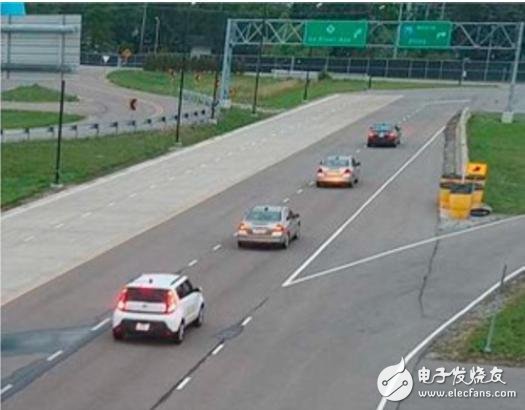According to foreign media reports, the University of Michigan (UM) uses the workshop communication (V2V) technology to enable autopilot vehicles to respond to other road users in a timely manner, helping them to save energy and improve safety, thus verifying the efficiency of the interconnected cruise control system.
The team demonstrated many of the benefits of Connected Cruise Control in the road test, which enabled only one self-driving car to be compared to other vehicles. Interconnected cruise control adjusts the speed of the vehicle, depending on the information acquired by its workshop communication system. The surrounding vehicles can use the wireless network to share real-time vehicle speed and positioning data.

Compared to other widely used adaptive cruise systems, the Interconnected Cruise Control System can track multiple vehicles ahead. The University of Michigan road test demonstrates how the system and the workshop communication between autonomous vehicles and traditional vehicles can help avoid "Traffic wave". In this scenario, the foremost car will trigger a "braking and re-acceleraTIng" chain reaction of other vehicles. When the self-driving vehicle with interconnected cruise control takes braking, its gravity value is reduced by 60% compared to conventional manned vehicles.
In the completion of the brake-to-acceleration operation, the energy-saving efficiency of the V2V-equipped autonomous vehicle is 19% compared to the non-interconnected and self-driving vehicles.
If the on-board sensor is the only source of information for an autonomous vehicle, when the current vehicle suddenly takes a brake operation, the response time of the vehicle is extremely short, and it is difficult to avoid a potential collision accident, which is almost the same as that of a conventional vehicle. The University of Michigan's R&D team performed a series of V2V interconnected autonomous vehicle tests that received motion information from the vehicles ahead and received information on up to six vehicles.
The research team also found that the V2V autopilot algorithm can achieve energy savings in the context of stop-and-go road conditions compared to traditional sensor-based algorithms. Due to the relatively flat speed, conventional vehicles located behind the self-driving vehicle can also achieve 7% energy savings.
A slip ring is an electromechanical device that allows electricity and data to pass through a rotating assembly. A mercury slip ring uses liquid mercury as the electrically conductive element inside the rotating assembly, as opposed to traditional carbon brushes. Mercury is a better conductor of electricity than carbon, and it also has a very low contact resistance. This makes it an ideal choice for applications that require high-speed data transmission or where reliability is critical. Mercury slip rings are used in a variety of industries, including medical technology, aerospace, and defense.
Why do we choose a mercury slip ring?
A slip ring is an electromechanical device that allows electrical current to pass between rotating objects. Slip rings are often used in applications where a cable or connector would otherwise twist and tangle as the object rotates. There are many different types of slip rings, but one of the most common is the mercury slip ring. Mercury slip rings offer several advantages over other types of slip rings, including high reliability, low maintenance, and long life. Here are three reasons why we choose a mercury slip ring:
1. Reliability: Mercury is an extremely reliable material, and mercury slip rings are among the most reliable types of slip rings available. Mercury has a very low failure rate, and it is not affected by changes in temperature or humidity. This makes mercury slip rings ideal for critical applications where reliability is essential.
2. Low Maintenance: Mercury slip rings require very little maintenance. Because mercury is a very inert substance, it does not corrode or generate any corrosive gases that would affect its reliability. Mercury slip rings do not require any lubrication, and they can operate in a wide range of temperatures and environments.
3. Economical Mercury slip rings have a lifetime cost advantage over other types of slip rings as well. Generally speaking, mercury slip rings are approximately 25% more expensive per kilowatt than other types of slip rings. However, because they require less maintenance and have a greater degree of reliability than other types of slip rings, they will save you money over the lifetime of your equipment.
Mercury Slip Ring,Slip Ring Gigabit Ethernet,Slip Ring 400V,Slip Ring Pneumatic
Dongguan Oubaibo Technology Co., Ltd. , https://www.sliprob.com
